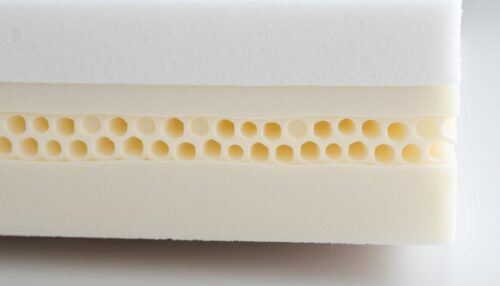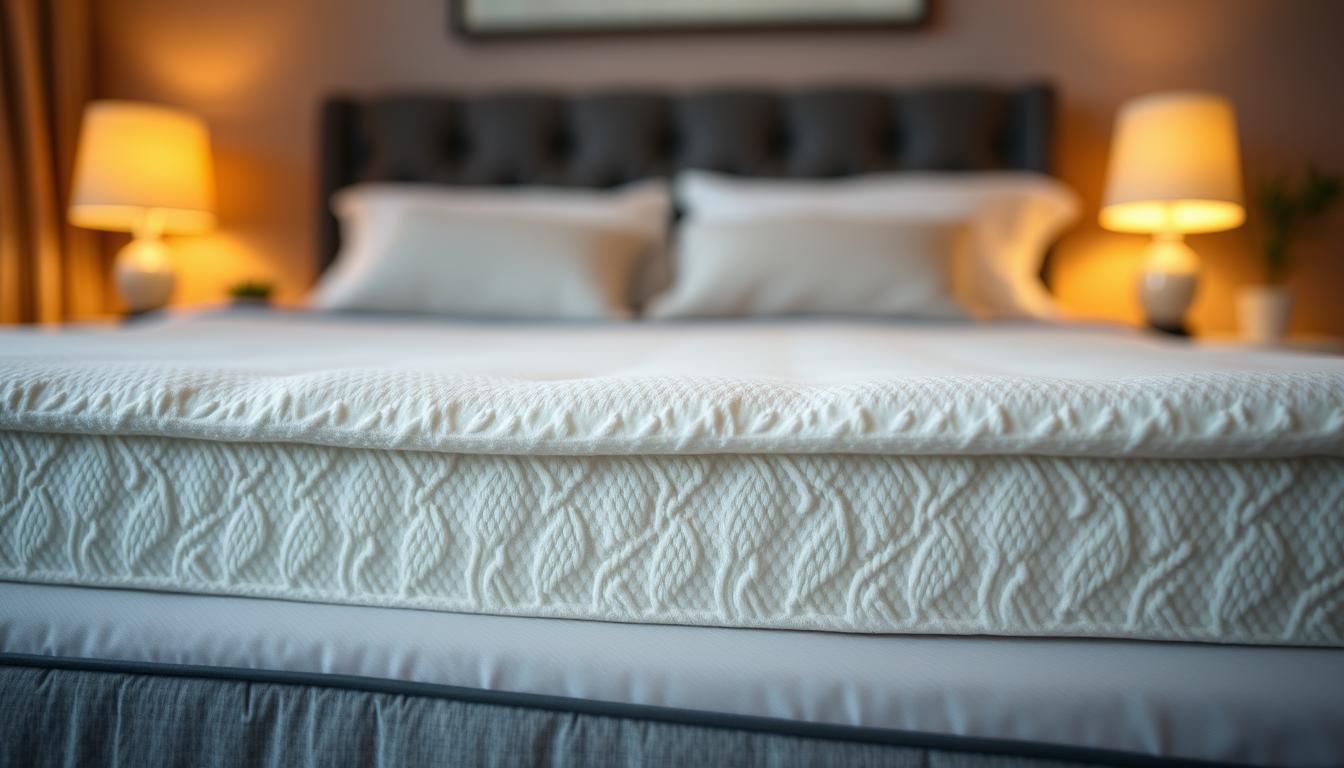Disclosure
This website is a participant in the Amazon Services LLC Associates Program, an affiliate advertising program designed to provide a means for us to earn fees by linking to Amazon.com and affiliated sites.
Memory foam mattress toppers are popular for comfort and pressure relief. But, they also raise health concerns. Issues include chemicals used in making them and the release of harmful gases.
Many memory foam products are now safer and greener. It’s important to know about health risks before buying. This way, you can choose a topper that’s good for you and feels great.
Key Takeaways:
- Memory foam mattress toppers may contain harmful chemicals like toluene diisocyanate, formaldehyde, and flame retardants.
- Off-gassing of VOCs can cause breathing problems and bad smells, mainly in cheaper memory foam.
- Certifications like CertiPUR-US and GREENGUARD Gold show low VOC levels and no harmful stuff in memory foam.
- People with breathing issues or allergies might like natural latex toppers better.
- Keeping memory foam toppers clean and replacing them often is key to a safe sleep space.
Understanding Memory Foam Mattress Toppers
Memory foam mattress toppers are popular for better comfort and pressure relief. They are made from viscoelastic memory foam. This material was first used by NASA for astronauts.
These toppers adjust to your body’s heat and pressure. They shape to fit you, offering support that feels just right.
What are Memory Foam Mattress Toppers?
These toppers add comfort and support on top of your mattress. They are made from a special foam. This foam is a mix of polyurethane, polyols, diisocyanates, and blowing agents.
This mix makes the foam slow to respond. It also helps relieve pressure.
How Do They Work?
When you lie on a memory foam topper, it molds to your body. It does this by responding to your heat and pressure.
This pressure relief helps ease aches and pains. It does this by reducing stress on your body’s pressure points.
The foam also stops motion from transferring. This means you can sleep well, even if your partner moves.
Common Benefits of Using Them
- Pressure relief and improved spinal alignment
- Reduced motion transfer for undisturbed sleep
- Customized support and contouring to your body shape
- Durable and long-lasting performance
- Hypoallergenic and resistant to dust mites and other allergens
Modern memory foam toppers don’t retain heat like old ones did. They use plant-based materials and eco-friendly agents. This helps keep you cool and comfortable.
When choosing a memory foam topper, think about what you need. Everyone is different, so find the one that fits you best.
Potential Health Concerns
Memory foam mattress toppers are comfy and relieve pressure. But, they can also cause health worries. These worries are about off-gassing, allergens, and how they handle temperature.
VOCs and Off-Gassing
Memory foam can release harmful chemicals called VOCs when it’s new. This can make it smell like cleaning products. These chemicals can make you feel sick, give you headaches, and more.
Memory foam off-gassing is a big problem. It needs good air flow when you first use it.
Allergens and Dust Mites
Memory foam can attract dust mites because it’s so dense. These tiny bugs and their waste can build up. This can make people with allergies or asthma very sick.
Temperature Sensitivity
Memory foam can also make you feel too hot. It hugs your body too tightly, which can be uncomfortable. This VOCs in memory foam make it harder to cool down, which can mess up your sleep.
Even though newer memory foam is better, it’s still important to be careful. Talk to doctors and check for things like CertiPUR-US. This helps you choose the right memory foam mattress topper.
https://www.youtube.com/watch?v=JT8mcurV1Zg
The Science Behind Memory Foam
Memory foam is loved for its special qualities. It’s made mostly of polyurethane, with extra chemicals to make it thicker and stickier. This helps it hug your body, which can make sleeping better by easing pressure and helping your spine stay straight.
Composition of Memory Foam
Memory foam is mostly polyurethane, a man-made material. It also has other stuff to make it work better. Different makers use different mixes, some greener or safer for your health. They try to keep it comfy and breathable, yet strong.
How It Affects Sleep Patterns
Memory foam keeps heat, which can mess with your sleep. But, it also molds to your body, easing pressure and helping your spine. To fix the heat issue, some makers add cool features or make it more air-permeable.
Memory foam’s science shows it offers custom support and comfort. But, it also raises questions about heat and health. Knowing how it works can help you pick the right memory foam for your bed or pillow.

Safety Standards of Memory Foam
Memory foam mattress toppers have become much safer in recent years. New rules have been made to stop harmful chemicals. These rules check for emissions, content, and how long the foam lasts.
Certification and Regulations
The CertiPUR-US® seal is a big deal for memory foam. It means the foam is safe from ozone depleters, flame retardants, and heavy metals. It also means the foam doesn’t release many harmful gases.
Importance of Choosing CertiPUR-US Products
When you’re looking for a memory foam topper, make sure it’s CertiPUR-US® certified. These foams don’t have harmful stuff like formaldehyde or phthalates. Choosing CertiPUR-US certified memory foam means you’re getting a safe and comfy sleep surface.
| Certification | Key Requirements |
|---|---|
| CertiPUR-US® |
|
Factors to Consider Before Buying
Choosing a memory foam mattress topper needs careful thought. Think about your health and how you sleep. Memory foam can be great, but it must fit your needs.
Personal Health Conditions
If you have breathing problems, allergies, or sensitive skin, check the materials. Some memory foam toppers have chemicals that can cause issues. Look for ones that are CertiPUR-US certified. They have low emissions and no harmful stuff.
Sleep Position and Preference
Your sleep position is key when picking a memory foam topper. Side sleepers get great pressure relief and shape from memory foam. Back and stomach sleepers might need something firmer to keep their spine straight. Think about your comfort and any pain before buying.

People with chronic pain or joint issues might find memory foam helps them sleep better. But, if you get too hot at night, memory foam might not be the best. It can keep heat in.
Comparing Alternatives
Looking for the best mattress topper? There are many options other than memory foam. Latex toppers are natural and eco-friendly. They offer similar comfort and last longer than memory foam.
Latex Mattress Toppers
Latex toppers are great for those who want a breathable surface. They are firmer than memory foam, perfect for side sleepers. Plus, latex fights mold and dust mites, good for allergy sufferers.
Traditional Fiber Mattress Toppers
Wool or down toppers feel different from memory foam. They are cooler because they breathe better. Wool is also good for allergies and is eco-friendly.
| Mattress Topper Type | Firmness | Temperature Regulation | Durability | Environmental Impact |
|---|---|---|---|---|
| Latex | Firm | Excellent | High | Eco-friendly |
| Memory Foam | Soft | Poor | Moderate | Varies (some are eco-friendly) |
| Wool | Medium | Excellent | High | Eco-friendly |
| Down | Soft | Good | Moderate | Varies (some are eco-friendly) |
Each topper has its own benefits and downsides. Think about your sleep needs and health when choosing. Check out memory foam alternatives for a greener, more comfy sleep.
Impact on Body Alignment
The right mattress topper can change your sleep and health a lot. Memory foam mattress toppers are great because they fit your body’s shape. They give you pressure relief and help keep your spinal alignment right.
Spine and Joint Health
Bad sleeping can cause many issues, like pins and needles. Memory foam mattress toppers help by keeping your spine straight. They support your body’s pressure points, easing back, hips, and shoulders.
This helps your joint health and lowers back pain risk.
Pressure Relief Benefits
- Mattress toppers help with back pain and keep your spine aligned.
- The right topper thickness can greatly improve your sleep and give pressure relief.
- Organic latex toppers are best for pressure relief and easing shoulder, back, and hip pain.
The right mattress topper can greatly improve your body alignment. It lets you wake up feeling refreshed and without pain. A quality topper is key to better health and a comfortable sleep.
Selecting the Right Topper
Choosing the right memory foam mattress topper is key. Think about thickness and firmness. Toppers are usually 1 to 4 inches thick. Thicker ones give more cushioning and support.
Firmness matters too. Memory foam comes in soft to extra firm. This lets you pick the right feel for your sleep style and comfort.
Thickness and Firmness Choices
- Thicker toppers (2-4 inches) are great for side and back sleepers. They offer deep comfort and support.
- Thinner toppers (1-2 inches) are better for those who like a firmer bed. They’re good for stomach sleepers.
- Firmness ranges from soft (3-5) to firm (7-9). This lets you find the perfect support for you.
How to Test Before Buying
It’s important to test a topper before buying. Many offer sleep trials at home. You can try it on your current mattress for 30 days or more.
If trials aren’t available, visit a store. Lie down on different toppers to feel their thickness and firmness. This helps you choose wisely.
| Topper Thickness | Ideal For | Firmness Level |
|---|---|---|
| 1-2 inches | Stomach and back sleepers | Firm (7-9) |
| 2-4 inches | Side and back sleepers | Soft (3-5) to Medium (5-7) |
Maintenance and Care
Keeping your memory foam mattress topper in good shape is key. Regular cleaning and smart storage help keep it in top condition. This way, your topper stays supportive and clean for a long time.
Cleaning Your Mattress Topper
Cleaning your memory foam mattress topper often is important. It keeps it clean and stops dust, debris, and allergens from building up. For small stains, use a mild soap and water carefully. Don’t soak the foam.
Many toppers have covers that can be washed in a machine. This makes cleaning easy.
Extending Its Lifespan
- Rotate your mattress topper every few months to ensure even wear and tear.
- Use a mattress protector or cover to shield your topper from spills and stains.
- Avoid exposing your topper to direct sunlight or excessive moisture, as this can damage the foam.
By following these easy tips, you can extend the lifespan of your memory foam mattress topper. You’ll enjoy its comfort and support for many years.
| Maintenance Recommendation | Lifespan Impact |
|---|---|
| Regular Cleaning (Weekly Vacuuming) | Prevents Dust and Debris Buildup |
| Rotating the Topper Every 3-4 Months | Ensures Even Wear and Tear |
| Using a Mattress Protector | Shields Topper from Spills and Stains |
| Avoiding Direct Sunlight | Prevents Foam Damage |
By following these best practices, you can maintain the quality and longevity of your memory foam mattress topper. This ensures a comfortable and supportive sleep for years to come.
Making an Informed Decision
Choosing a memory foam mattress topper needs careful thought. It’s important to talk to health experts, if you have health issues. This is because the topper’s materials and design might affect you.
Consulting with Health Professionals
Talking to your doctor can give you important advice. They can tell you how a memory foam topper might affect your health and sleep. They’ll suggest what’s best for you, considering any allergies or joint problems.
Reading Reviews from Other Users
Looking at what others say can also help. Find reviews from people with health issues or sleep needs like yours. Look for comments on comfort, how long it lasts, and any health effects. Also, check the maker’s reputation and if they’re open about their materials and certifications.
By talking to doctors and reading reviews, you can decide if a memory foam memory foam topper reviews is right for you. Always put your health first when picking a mattress topper.
Conclusion: Are They Right for You?
Choosing a memory foam mattress topper depends on your needs and health. Modern memory foam is mostly safe, but some people might be more sensitive. Think about the memory foam topper benefits like comfort and the memory foam topper risks like heat or off-gassing.
Weighing the Pros and Cons
Look for certified products if health is a big worry. Memory foam toppers can be very comfortable and supportive. But, they might not be the best for everyone. Think about your sleep position, body type, and health issues to decide if it’s right for you.
Final Thoughts on Health and Comfort
The best choice is one that balances comfort and health. Talk to doctors and read what others say to make a good choice. Knowing the good and bad points helps you pick a memory foam topper that improves your sleep without hurting your health.

